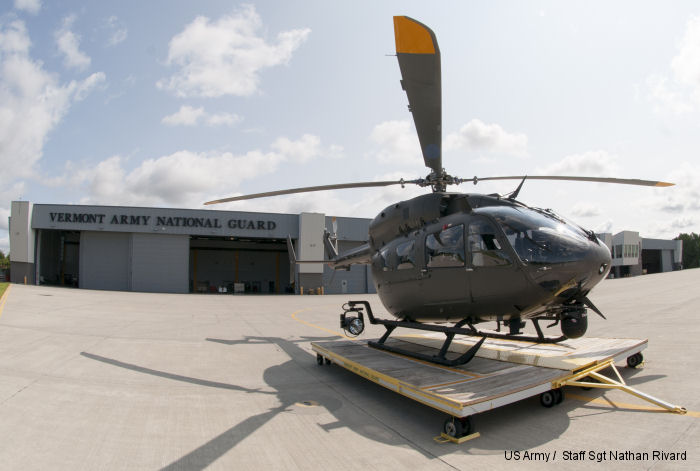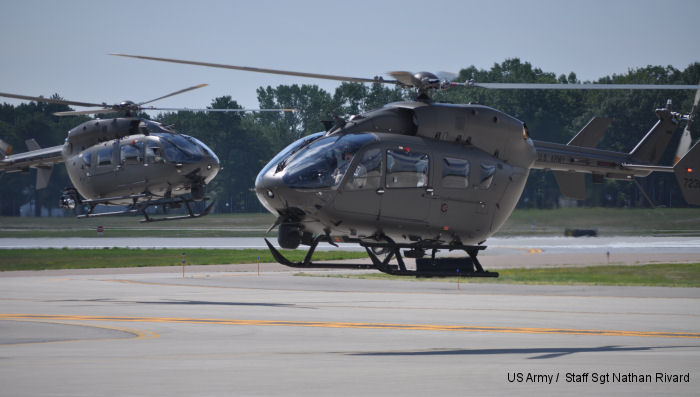US Army, August 06, 2014 - SOUTH BURLINGTON, VT by Staff Sgt. Nathan Rivard - The Army Aviation Facility in South Burlington saw the landing of two new pieces of equipment to help push flying into the future.
Two UH-72 MEPS Lakota helicopters were flown from Meridianville, Alabama, to the facility in South Burlington during the weekend.
“The Army retired the OH-58 that we had,” said Lt. Col. John Johnston, state aviation officer. “It was the last single engine airframe that the Army was operating, so now all of the aircraft in the Army inventory dual-engine aircraft.”
The Vermont crews received two weeks of training on the new helicopters before flying them back home to replace Vermont’s OH-58 Kiowa, which have been used since the late '80s and early '90s, according to Chief Warrant Officer 3 Kevin Carvey.
“The helicopters that we replaced were a 1972 and a 1973,” said Carvey. “Each of them has had over 7,000 flight hours put on them. We recently got divested of those by sending them to Kentucky where they will be fielded to law enforcement or sold to law enforcement.”
Seven-thousand flight hours is roughly the equivalent of flying the helicopter 75 minutes a day, every day, since Vermont first received the helicopters.
As time passes and technology progresses, so does the equipment in the helicopters.
“The autopilot is a nice feature,” said Johnston as he explains the technology upgrades. “It gives you more options from a crew member standpoint on how you operate the systems. Because of the range of the aircraft as well, it’ll give us a longer on station time and a little more comfortable on station time, so we can focus on the task of searching or whatever the mission is.”
The UH-58 Kiowas did not have autopilot and pilots had to stabilize in the air, which was just another task added to their long list of duties. This new feature allows crews to put more time carrying out their mission instead of just flying.
“These are, I would say 90-percent better in as much as the technology that provides the stabilization, it reduces pilot workload,” said Carvey. “With this having autopilot and stability systems it’s going to reduce the pilot workload and be able to focus more on the mission.”
“The main use would be defense support to civil authorities,” said Carvey. “In cases such as Irene, search and rescue, or as other units have done, gone to the southwest border to supplement the Border Patrol or Homeland Security. Other units have also been very active during 9/11 or during major events; Units will provide security and support in particularly with video footage or with communications because we have a very robust communications suite.”
The video footage is one of the most improved upgrades for the new helicopters. A new downlink system is able to send video from the air to the ground effortlessly.
“One of the profits that we will receive by having this aircraft is we are going to be take whatever footage that we get form the air and real-time send it to the ground in either a digital or analog signal,” said Carvey. “The ground or incident commanders will be able to make decisions with the best situational awareness as a result of this.”
Carvey stated this ability has up to a 30-nautical-mile range and can send video in higher definition than the former analog system. The ability to relay information from the sky to the ground through multiple agencies is one of the key goals.
The upgrades and new features didn’t happen for just the two helicopters either. The aviation facility itself has seen substantial upgrades that streamline helicopter maintenance.
“It’s a great facility,” said Johnston with a pride-filled smile. “The work stations allow us to plug the aircraft into the work stations and operate all of the systems inside the hangar without having to bring them out, so we can troubleshoot and do any maintenance procedures that are called for without actually bringing the aircraft outside and starting them, so in the Winter months that’s a great advantage.”
The facility is more efficient, accommodating, and helps cut costs on helicopter use.
“You don’t have to move an aircraft to perform a maintenance function,” said Johnston.
That increases the operational readiness rate and is a great training aid. We can operate all of the systems on the aircraft inside the hangar. It allows soldiers to come in and look at the systems without having to bring them outside and start them which costs money.
While it may be impossible to know how long a helicopter will last, Carvey believes if the previous aircraft are any indication of life expectancy they should be 40 years or more. The trained soldiers, great working facility, and how well the previous helicopters were taken care of should be a testament to that belief.
Two UH-72 MEPS Lakota helicopters were flown from Meridianville, Alabama, to the facility in South Burlington during the weekend.
“The Army retired the OH-58 that we had,” said Lt. Col. John Johnston, state aviation officer. “It was the last single engine airframe that the Army was operating, so now all of the aircraft in the Army inventory dual-engine aircraft.”
The Vermont crews received two weeks of training on the new helicopters before flying them back home to replace Vermont’s OH-58 Kiowa, which have been used since the late '80s and early '90s, according to Chief Warrant Officer 3 Kevin Carvey.
“The helicopters that we replaced were a 1972 and a 1973,” said Carvey. “Each of them has had over 7,000 flight hours put on them. We recently got divested of those by sending them to Kentucky where they will be fielded to law enforcement or sold to law enforcement.”
Seven-thousand flight hours is roughly the equivalent of flying the helicopter 75 minutes a day, every day, since Vermont first received the helicopters.
As time passes and technology progresses, so does the equipment in the helicopters.
“The autopilot is a nice feature,” said Johnston as he explains the technology upgrades. “It gives you more options from a crew member standpoint on how you operate the systems. Because of the range of the aircraft as well, it’ll give us a longer on station time and a little more comfortable on station time, so we can focus on the task of searching or whatever the mission is.”
The UH-58 Kiowas did not have autopilot and pilots had to stabilize in the air, which was just another task added to their long list of duties. This new feature allows crews to put more time carrying out their mission instead of just flying.
“These are, I would say 90-percent better in as much as the technology that provides the stabilization, it reduces pilot workload,” said Carvey. “With this having autopilot and stability systems it’s going to reduce the pilot workload and be able to focus more on the mission.”
“The main use would be defense support to civil authorities,” said Carvey. “In cases such as Irene, search and rescue, or as other units have done, gone to the southwest border to supplement the Border Patrol or Homeland Security. Other units have also been very active during 9/11 or during major events; Units will provide security and support in particularly with video footage or with communications because we have a very robust communications suite.”
The video footage is one of the most improved upgrades for the new helicopters. A new downlink system is able to send video from the air to the ground effortlessly.
“One of the profits that we will receive by having this aircraft is we are going to be take whatever footage that we get form the air and real-time send it to the ground in either a digital or analog signal,” said Carvey. “The ground or incident commanders will be able to make decisions with the best situational awareness as a result of this.”
Carvey stated this ability has up to a 30-nautical-mile range and can send video in higher definition than the former analog system. The ability to relay information from the sky to the ground through multiple agencies is one of the key goals.
The upgrades and new features didn’t happen for just the two helicopters either. The aviation facility itself has seen substantial upgrades that streamline helicopter maintenance.
“It’s a great facility,” said Johnston with a pride-filled smile. “The work stations allow us to plug the aircraft into the work stations and operate all of the systems inside the hangar without having to bring them out, so we can troubleshoot and do any maintenance procedures that are called for without actually bringing the aircraft outside and starting them, so in the Winter months that’s a great advantage.”
The facility is more efficient, accommodating, and helps cut costs on helicopter use.
“You don’t have to move an aircraft to perform a maintenance function,” said Johnston.
That increases the operational readiness rate and is a great training aid. We can operate all of the systems on the aircraft inside the hangar. It allows soldiers to come in and look at the systems without having to bring them outside and start them which costs money.
While it may be impossible to know how long a helicopter will last, Carvey believes if the previous aircraft are any indication of life expectancy they should be 40 years or more. The trained soldiers, great working facility, and how well the previous helicopters were taken care of should be a testament to that belief.
See also |
UH-72A Lakota in






